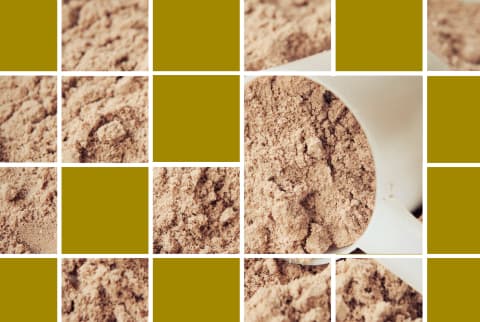Advertisement
The Rise Of The Functional Flexitarian: How Protein Will Shape 2023 Food Trends



It wasn't long ago that protein powders were almost exclusively packaged in bulky tubs with decidedly macho fonts and imagery. This only perpetuated the myth that if someone's maximizing their protein intake, they must be a gym rat or professional bodybuilder.
Now, we're seeing the packaging for animal and plant proteins become more universal and less targeted. This might seem like an inconsequential shift, but it speaks to the essential fact that everybody needs to pay attention to protein if they want to live a long, healthy life.
Protein needs for thriving, not just surviving.
There are many reasons to prioritize protein. For starters, it's a building block of muscles, and muscle mass is a predictor of longevity and healthspan. Protein is also the most satiating macronutrient, so it can ease hunger and prevent overeating1, reducing one's likelihood of developing obesity, heart disease, diabetes, and a number of other chronic illnesses. (Though you need to make sure you're eating the right types of protein, which we'll get to later.)
"Since protein sufficiency is known to be utterly critical for optimal energy, immunity, metabolic function, musculoskeletal health, hormonal balance, recovery, and more, I cannot think of a more whole-body relevant macronutrient for ensuring a long, healthy life," says Ashley Jordan Ferira, Ph.D., RDN, mindbodygreen's vice president of scientific affairs.
The current Recommended Dietary Allowance (RDA) for protein is 0.8 gram of protein per kilogram of body weight per day. This is in line with what most American adults are eating, says metabolic health expert Alexis Cowan, Ph.D. But, "this is going to totally fall short of what's optimal," she warns.
That's because the RDA is an estimate for the minimum amount of protein that you need to eat in order to avoid nitrogen imbalance and muscle loss. But, as protein and amino acid requirements researcher Don Layman, Ph.D., tells mindbodygreen, "Nobody I know is after minimum health. We're after optimum health."
Now, a growing chorus of health and nutrition experts are encouraging people to go beyond the RDA2 and increase protein intake to closer to 1.2 to 1.6 grams per kilogram of body weight (roughly 110 to 120 grams a day)—especially in older age since our ability to efficiently convert protein into muscle declines after we turn 603 or so.
As for when to get that protein, the first and last meals of the day are most important. After a period of sleep, a protein-packed breakfast activates muscle hypertrophy (growth of muscle cells) for the day. Layman recommends 30 to 40 grams of protein at breakfast, while the average American currently consumes around 12 grams.
Not all protein is created equal.
When it comes to building muscle, complete (containing all nine essential amino acids) proteins from animal products are the most effective. Think lean meats or whey protein powder. Plant proteins tend to have a lower content of amino acids like leucine, which is considered the most important for muscle protein synthesis4.
Even if all nine of these amino acids are in a plant protein, says Layman, they won't necessarily be present in the right amounts. He puts it like this: Plants' amino acids are balanced to produce leaves and stems and flowers—which are pretty different from brains and livers and muscles.
"Another nuanced consideration is digestibility since animal protein has higher bioavailability than plant protein," adds Ferira.
Now, all the experts interviewed for this piece agree that it is possible to get optimal protein on a plant-based diet. But keeping your intake of calories and other macronutrients in check will take effort.
For example, black beans are an excellent source of plant protein—but they have a carb-to-protein ratio of about 4 to 1. "If you're trying to get 100 grams of protein, that means you're getting 400 grams of carbohydrates," Layman says. "Your body can't tolerate that... We need strategies that allow people to lower their calories and still maintain their protein intake."
The rise of the functional flexitarian.
It should come as no surprise that the wellness world—particularly the nutrition space—is polarized. On the one hand, you have people who eat 100% vegan. On the other, you have the carnivore diet. But for the sake of healthy protein (something that all of us should be counting) we'd be better off taking a more balanced approach.
"I don't necessarily think that anything needs to be in extremes," says functional medicine doctor Gabrielle Lyon, D.O. "Ultimately we will come back to something in the middle."
Thankfully, we seem to be starting to head in that direction. There continues to be interest in plant-based diets, but people are adding sustainably sourced animal protein back onto their plates too.
For the first time in years, more people were consistently Google searching the carnivore diet than the vegan diet in 2022. Meanwhile, searches for complete proteins are also on the rise—signaling an increased awareness of the importance of protein quality. We've seen similar shifts in the mindbodygreen audience, and more people identified as omnivorous (34%) than vegan or vegetarian (31%) in our most recent reader survey. Online organic grocer Thrive Market is also seeing a movement toward flexitarian eating styles; Thrive representatives tell mindbodygreen that their customers are consuming more protein-rich diets—from a mix of both animal and plant proteins.
All this points to a need for healthy and sustainable sources of both plant and animal proteins in 2023.
For the first time in years, more people were consistently Google searching the carnivore diet than the vegan diet in 2022.
Coming off of a record $5 billion invested in the alternative protein market in 2021, we expect to see more meat alternatives—particularly those that are formulated to be complete proteins—continue to come to market. Animal protein isn't going anywhere either—but like plant protein, it needs to be created with optimal nutrition in mind.
That means less factory farming and more regenerative ranching. Meat from animals that are raised on a ranch that uses techniques like managed grazing and natural fertilizers and pesticides tends to be leaner and more protein- and nutrient-dense, says Cowan, meaning it takes less of it to fulfill our protein requirements. "I think that's really the future," she predicts, "Getting that nutrient density with less quantity."
Takeaway of the trend.
We at mindbodygreen are all for Michael Pollan's pared-down approach to nutrition and have long preached the "Eat food. Not too much. Mostly plants" lifestyle. But we're proposing an addition to the mantra: "Don't forget the protein." Looking ahead, we'll all need to be intentional about how we get it on our plate in a sustainable and healthy way—no matter what diet we follow.
Watch Next
Enjoy some of our favorite clips from classes
Enjoy some of our favorite clips from classes
What Is Meditation?
Mindfulness/Spirituality | Light Watkins
Box Breathing
Mindfulness/Spirituality | Gwen Dittmar
What Breathwork Can Address
Mindfulness/Spirituality | Gwen Dittmar
The 8 Limbs of Yoga - What is Asana?
Yoga | Caley Alyssa
Two Standing Postures to Open Up Tight Hips
Yoga | Caley Alyssa
How Plants Can Optimize Athletic Performance
Nutrition | Rich Roll
What to Eat Before a Workout
Nutrition | Rich Roll
How Ayurveda Helps Us Navigate Modern Life
Nutrition | Sahara Rose
Messages About Love & Relationships
Love & Relationships | Esther Perel
Love Languages
Love & Relationships | Esther Perel

















